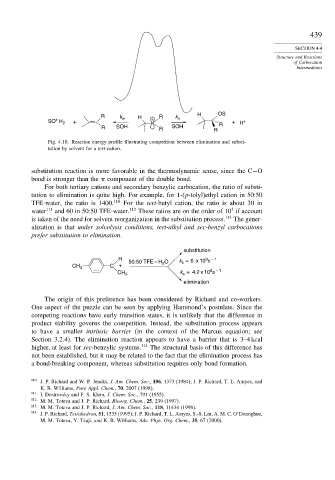Page 458 - Advanced Organic Chemistry Part A - Structure and Mechanisms, 5th ed (2007) - Carey _ Sundberg
P. 458
439
SECTION 4.4
Structure and Reactions
of Carbocation
Intermediates
R k e H R k s H OS
+
SO H 2 + + R + H +
R SOH R SOH R
Fig. 4.10. Reaction energy profile illustrating competition between elimination and substi-
tution by solvent for a tert-cation.
substitution reaction is more favorable in the thermodynamic sense, since the C−O
bond is stronger than the component of the double bond.
For both tertiary cations and secondary benzylic carbocation, the ratio of substi-
tution to elimination is quite high. For example, for 1-(p-tolyl)ethyl cation in 50:50
TFE-water, the ratio is 1400. 110 For the tert-butyl cation, the ratio is about 30 in
3
water 111 and 60 in 50:50 TFE-water. 112 These ratios are on the order of 10 if account
is taken of the need for solvent reorganization in the substitution process. 113 The gener-
alization is that under solvolysis conditions, tert-alkyl and sec-benzyl carbocations
prefer substitution to elimination.
substitution
H 50:50 TFE – H O k = 6 x 10 s
9 – 1
CH 3 C + 2 s
6 – 1
CH 3 k = 4.2 x 10 s
e
elimination
The origin of this preference has been considered by Richard and co-workers.
One aspect of the puzzle can be seen by applying Hammond’s postulate. Since the
competing reactions have early transition states, it is unlikely that the difference in
product stability governs the competition. Instead, the substitution process appears
to have a smaller intrinsic barrier (in the context of the Marcus equation; see
Section 3.2.4). The elimination reaction appears to have a barrier that is 3–4 kcal
higher, at least for sec-benzylic systems. 114 The structural basis of this difference has
not been established, but it may be related to the fact that the elimination process has
a bond-breaking component, whereas substitution requires only bond formation.
110 J. P. Richard and W. P. Jencks, J. Am. Chem. Soc., 106, 1373 (1984); J. P. Richard, T. L. Amyes, and
K. B. Williams, Pure Appl. Chem., 70, 2007 (1998).
111 I. Dostrovsky and F. S. Klein, J. Chem. Soc., 791 (1955).
112
M. M. Toteva and J. P. Richard, Bioorg. Chem., 25, 239 (1997).
113 M. M. Toteva and J. P. Richard, J. Am. Chem. Soc., 118, 11434 (1996).
114
J. P. Richard, Tetrahedron, 51, 1535 (1995); J. P. Richard, T. L. Amyes, S.-S. Lin, A. M. C. O’Donoghue,
M. M. Toteva, Y. Tsuji, and K. B. Williams, Adv. Phys. Org. Chem., 35, 67 (2000).

